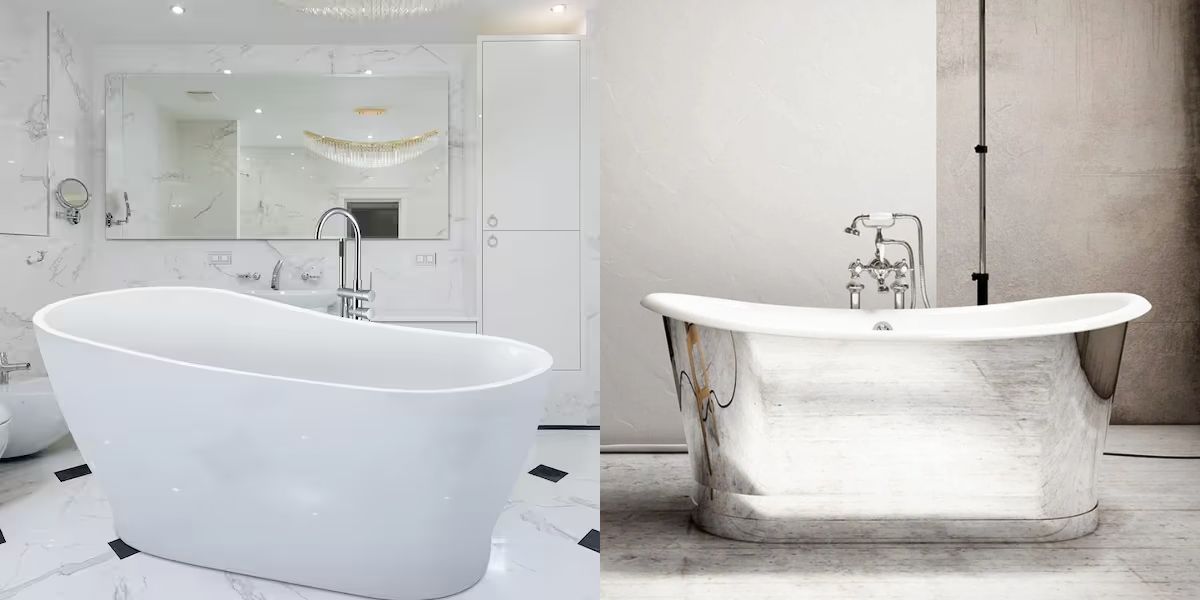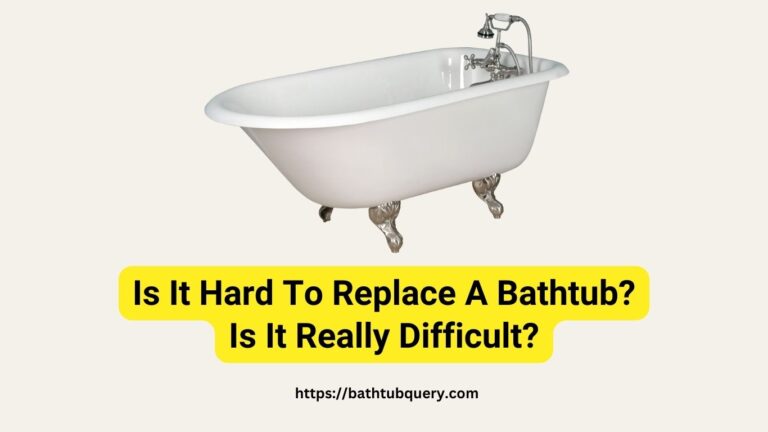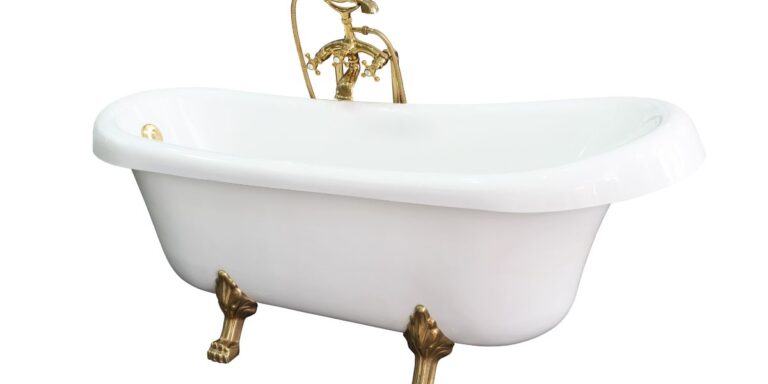Which is Better: Cast Iron or Acrylic Bathtubs?
Well, both materials have their own sets of pros and cons when it comes to factors like durability, cost, maintenance, and more. I’ve done extensive research on cast iron and acrylic bathtubs to provide an in-depth comparison, so you can determine which material is better suited for your needs.
What’s the Difference Between Cast Iron and Acrylic Bathtubs?
| Feature | Cast Iron | Acrylic |
|---|---|---|
| Durability | Extremely durable, lasts 50+ years | Less durable, lasts 10-25 years |
| Longevity | Can last generations with re-enameling | Needs replacing eventually |
| Heat Retention | Excellent, keeps water hotter longer | Poor, water cools faster |
| Mold Resistance | Porous enamel can develop mold if not cleaned | Has antimicrobial properties to resist mold |
| Cost | More expensive, $800-$4000+ | More affordable, $200-$800 |
| Installation | Excellent, keeps water hotter and longer | Easier DIY installation |
| Cleaning | Requires meticulous care and maintenance | Easy to clean with gentle cleaners |
| Repairs | Professional installation is often required | DIY repair kits can fix minor damage |
| Styles | Antique, vintage, clawfoot styles | Contemporary, classic styles including alcove inserts |
| Remodeling | Difficult, requires major construction | Insert tubs available, lightweight |
An Overview of Cast Iron and Acrylic Bathtubs
First, let’s start with a basic overview of what cast iron and acrylic tubs are all about.
Cast iron tubs have been around for well over a century, with their surge in popularity happening in the late 1800s. This type of bathtub is made from cast iron and coated with a layer of porcelain enamel. The porcelain coating gives it a glossy, smooth look that can last for decades. Cast iron tubs are extremely durable, but they come at a higher cost than acrylic.
Acrylic bathtubs were introduced in the 1950s as a lighter, more affordable alternative to cast iron. As the name suggests, these tubs are made from acrylic plastic that is reinforced with fiberglass to make it rigid. Acrylic is easy to clean and repair, though not quite as durable as cast iron over time. The material offers great design flexibility and comes in a range of style options.
Now let’s dig deeper into how cast iron and acrylic compare when it comes to factors like durability, cost, maintenance, and more.
Durability and Longevity: How Long Do They Last?
When shopping for a new bathtub, you probably want one built to stand the test of time. So how do cast iron and acrylic bathtubs stack up against each other when it comes to durability and longevity?
Cast iron tubs are practically unrivaled when it comes to durability. The cast iron itself is extremely strong and rigid, built to last 50 years or more with proper care. The vitreous porcelain enamel coating is also highly durable, resisting chips, scratches, and stains way better than acrylic. With routine maintenance and re-enameling as needed, a cast iron tub can easily remain in service for generations.
Acrylic bathtubs have decent durability thanks to the fiberglass reinforcement, but they cannot match cast iron’s staying power. The average acrylic tub will last anywhere from 10-25 years before needing replacement. Over time, acrylic can develop small cracks and scratches that compromise the integrity of the material. Heavy use causes it to show wear and tear faster than cast iron. Acrylic also tends to fade and dull over time, losing its glossy sheen.
If you want a tub that will be a long-lasting fixture, cast iron is certainly the way to go. You can even find antique cast iron tubs still in use after 50-100 years! For a tub you may replace in 10-15 years, acrylic offers reliable performance.
How Well Do They Retain Heat?
Another major consideration for any bathtub is how well it retains heat and keeps your bath water warm. After all, who wants to soak in lukewarm water that cools off too quickly?
Cast iron’s superior heat retention is one of its biggest advantages. The thick, dense iron mass readily absorbs heat. A cast iron tub will keep your bath water hot for a longer period of time than acrylic. The hot water lingers, so you can enjoy a steamy soak even after 30-45 minutes have passed.
Meanwhile, acrylic does not retain heat nearly as well. Because acrylic is a plastic material, it transfers heat faster than cast iron. You may notice your acrylic bathtub cooling down much quicker, with bath water losing its warmth after 15-20 minutes. The lighter acrylic walls simply do not have the thermal mass of thick cast iron.
If retaining bath water heat is a priority for your long soaking sessions, cast iron is easily the better choice. You just can’t beat it for keeping water hotter, and longer. Acrylic performs fine for quick baths, but not leisurely soaks.
Mold and Mildew Growth Risks
Like any frequently wet surface in a bathroom, bathtubs can develop mold and mildew buildup over time if not properly cleaned. Certain materials are more prone to these unsightly, unhealthy growths than others.
Acrylic has a leg up on cast iron when it comes to resisting mold and mildew. Most acrylic is formulated with antimicrobial properties to inhibit biological growth. The non-porous surface makes it more stain-resistant as well. Small amounts of mold and mildew may grow on acrylic over time, but it typically occurs slower than on cast iron.
The porous enamel coating on cast iron makes it more susceptible to mold infiltration and stains. Without thorough cleaning, soap scum and mineral deposits can accumulate in the pores and create an environment where mold flourishes. However, proper maintenance can prevent extensive mold issues in a cast iron tub.
If easy cleaning is a priority for you, acrylic’s antimicrobial properties give it an edge over cast iron for repelling mold and mildew. But with a consistent cleaning regimen, either material can look great for years.
Cost Comparisons: Which is More Affordable?
One of the biggest factors that sway many homeowners towards acrylic over cast iron is cost and budget. Let’s break down the cost differences.
In terms of the upfront purchase price, acrylic bathtubs are generally far more affordable. You can find many quality acrylic tubs in the $200 – $800 range. Some cheaper ones are under $200 for basic models. The flexible acrylic material also allows for lower manufacturing costs.
Cast iron commands a premium price, with costs typically ranging from $800 on the very low end, up to $4,000 or more for enameled, vintage-style cast iron tubs. The materials, construction methods, and finishing processes are more expensive compared to plastic acrylic. Many cast iron tubs cost well over $1,500.
Professional installation also impacts cost. Acrylic tubs are lightweight and easier for homeowners to maneuver into place. But cast iron weighs a staggering 300-700 pounds, requiring special equipment and professional installation, which can add $500 or more to the total price.
Over the long run, higher-quality cast iron tubs may save money by not needing replacement as often. But acrylic still wins out in terms of upfront affordability. For homeowners on a tight budget, acrylic provides great value.
Cleaning and Maintenance Needs
To keep any bathtub looking pristine, regular cleaning and maintenance are essential. Let’s look at what’s required for easy care of acrylic vs. cast iron tubs.
Acrylic is far easier to clean. Its non-porous surface resists staining and buildup of grime. Most dirt and soap scum wipes away easily with a gentle liquid cleanser and a soft sponge. Never use abrasive scouring pads, which can scratch acrylic. A thorough cleaning weekly or biweekly keeps it looking like new.
Cast iron demands more meticulous care. The enamel surface needs a gentle cleanser and non-abrasive scrub brush to clean without damaging the finish. Mineral oil helps seal and protect the coating. To fight soap buildup and stains, a yearly cleansing with white vinegar or commercial enamel cleaner is ideal.
Over time, chips and scratches to the enamel will need to be repaired by a professional to prevent rust. Re-enameling is also necessary every 10-15 years to refresh the finish. Proper maintenance is key for cast iron.
So if you want a tub that’s simpler to care for, acrylic is certainly lower maintenance than cast iron. But don’t let extra cleaning deter you from cast iron’s virtues.
Repairing Surface Damage
No matter how durable a material, bathtubs suffer nicks, dents, and scratches from dropped objects, improper cleaning, and rough usage over time. Fixing damage keeps your tub looking its best.
Minor chips or cracks in acrylic can often be repaired using DIY patch kits containing epoxy fillers or hardening agents. The kits smooth over scratches and small damaged spots on acrylic. Sometimes a bathtub professional is needed for structural cracks or extensive damage.
Repairing chips and scratches in a cast iron tub’s enamel finish is also possible, but requires refinishing. Re-enameling by a professional gives the tub a fresh new finish. But it’s expensive—often $400-$1,000 depending on damage severity. Bad cracks may necessitate a full replacement.
So while cast iron and acrylic both allow for some damage repair, fixing acrylic is typically faster and cheaper for minor issues. More significant damage is resolved faster by replacing acrylic, versus re-enameling cast iron.
Design and Style Options Available
Beyond the nuts and bolts of durability and cost, style may also impact your bathtub decision. Do cast iron and acrylic offer the kinds of design options you have in mind?
One advantage of acrylic is the versatility of styles. You can find acrylic tubs in shapes ranging from classic clawfoot styles to streamlined contemporary forms. Options include soaking tubs, air baths, walk-in tubs, corner tubs, and more. With seamless designs and integrated parts, acrylic delivers style flexibility.
Cast iron also spans classic to modern styles, but excels at vintage reproduction tubs. Authentic clawfoot, double slipper, and rolled rim styles made of solid iron provide a truly timeless look. For historic homes and vintage bathrooms, cast iron nails those old-world style details.
So while acrylic boasts wider design diversity, cast iron dominates in the classic, antique-looking category. Choose acrylic for a contemporary style on a budget, or iron if you prefer an aged aesthetic.
Ease of Replacing Existing Tubs
When undertaking a bathroom remodel, replacing an old tub with a new model is made easier with certain materials. Let’s see how cast iron and acrylic bathtubs compare for retrofitting existing spaces.
One advantage of acrylic is styles like alcove insert tubs specifically designed to fit in standard 5 x 5-ft tub spaces. With a lightweight acrylic insert tub, you can upgrade to a soaker or other style without altering plumbing. These snap right into an existing footprint.
Cast iron tubs are much trickier for renovations. Their weight usually necessitates removing existing walls and plumbing to place the new tub. Carrying an extremely heavy cast iron tub upstairs or to second-floor baths may also be impossible. Unless replacing a same-size iron tub, major construction is required.
In summary, acrylic offers big advantages for remodeling ease. Tailored insert tubs, affordable pricing, and lightweight material are ideal for retrofits. Cast iron works only if your current tub area can accommodate it without major changes.
The Bottom Line: Which Is the Better Choice?
After looking at the many comparisons between these two common tub materials—is cast iron or acrylic ultimately the better choice for your new bathtub?
For unrivaled durability and heat retention, cast iron delivers enduring performance that can’t be matched. It’s an unbeatable option if you want a tub that maintains its beauty for 50 years or more. Though expensive initially, a high-quality cast iron tub saves costs over time versus replacing acrylic.
However, acrylic is lighter, easier to install, and more affordable upfront despite less longevity. Maintenance is simpler than cast iron, and repairs are more DIY-friendly. For a contemporary style on a budget, acrylic makes sense.
Here are some final tips on deciding, Which One is Best.
- If the budget is tight, acrylic provides excellent value and quality.
- For vintage antique styling, cast iron is your best choice.
- Avoid very cheap acrylic tubs, as low quality won’t last.
- Weigh installing a heavy cast iron tub during a renovation.
- Clean and maintain either material well for lasting beauty.
Whether you choose stately and enduring cast iron or affordable and versatile acrylic, picking the right tub for your needs helps ensure relaxation in a rejuvenating bath sanctuary for many years to come. With this comprehensive comparison as your guide, you can shop for the perfect new tub with confidence. Happy bathing!
See also:
- Can Acrylic Tubs Be Refinished? How To Do It?
- Are Acrylic Bathtubs Toxic? Tub Certification and Testing
- Why Do Acrylic Bathtubs Crack? Factors That Lead To Cracking

William J. Bullock is a licensed plumber with over 15 years of experience installing and repairing bathtubs. He runs his own plumbing company in Greenville and serves residential and commercial clients. William is dedicated to providing honest, transparent advice to help homeowners make informed decisions about their bathroom renovations.
He has established expertise in selecting bathtubs, planning custom installations, diagnosing issues, and completing repairs. William aims to share practical tips and reliable recommendations based on extensive hands-on work. When he isn’t on a job site, William enjoys spending time with his family and volunteering at local community events. He takes pride in delivering quality service and enjoys helping people upgrade their homes.







